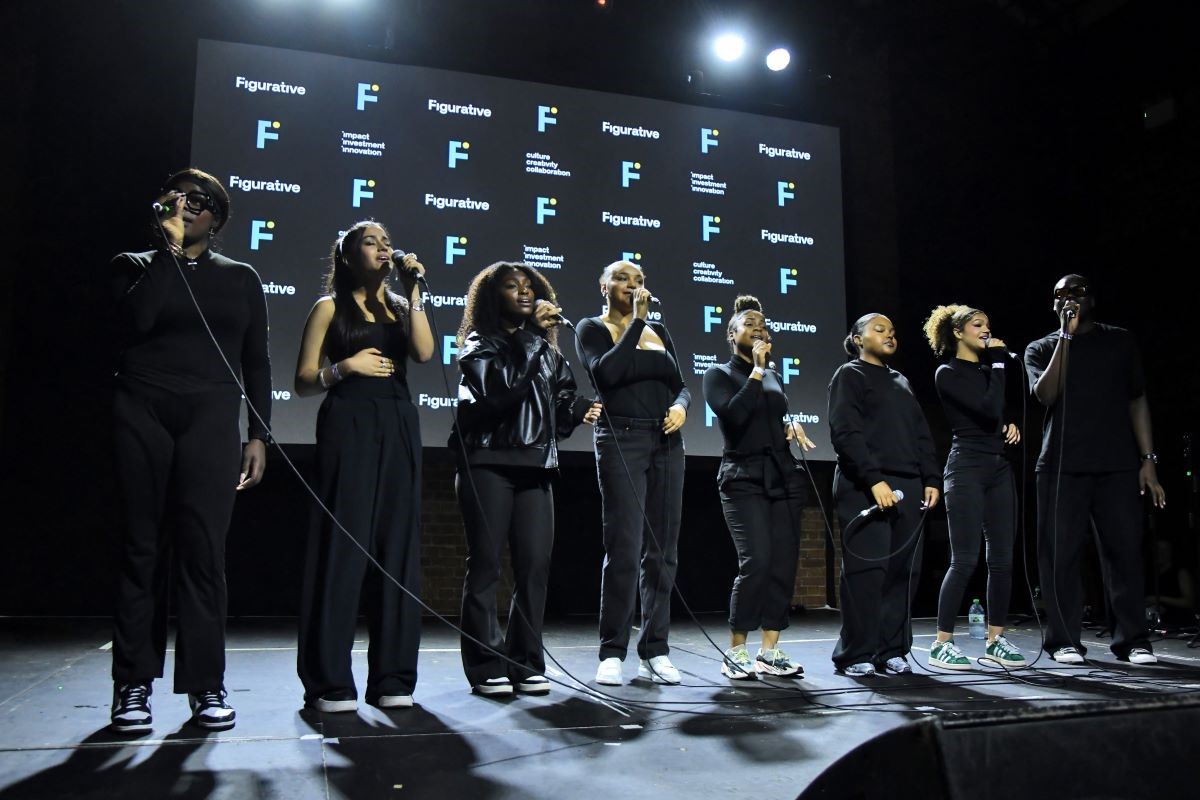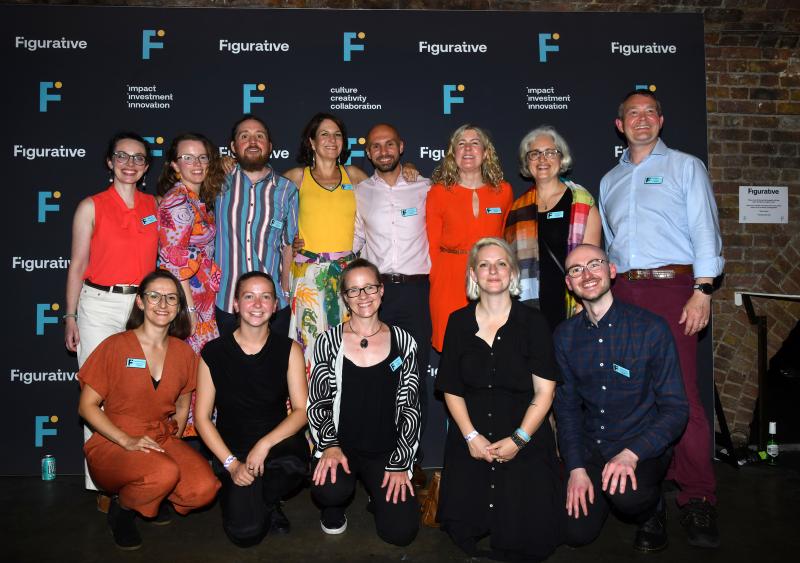
Flames Collective performing at Figurative's launch event at Village Underground in London
Photo: Leo Wilkinson Photography
The search for new funding and business models
There has been a lot of talk about the future of UK arts funding over the summer. Fran Sanderson has been assessing various funding streams to find ways to maximise their impact.
First there was Baillie Gifford’s decision to withdraw funding for several book festivals following a boycott campaign by Fossil Free Books, which sparked debate about how private sponsorship intersects with rising social and environmental activism in the sector.
Then, a report from The University of Warwick and the Campaign for the Arts revealed that the UK has one of the lowest levels of government spending on arts and culture in Europe.
The general election campaign, and Labour’s subsequent victory, prompted cultural organisations and leaders to put forward their own manifestos identifying funding priorities and calling for change.
The cultural and creative sector (CCS) is grappling with several challenges – stretched public funds, dwindling philanthropic engagement and a complex private funding environment – but there is also, evidently, momentum behind efforts to address them.
Models of collaboration
How can we stabilise and increase public, private and philanthropic funding streams? And how can we get them working better together, to maximise what we have in the meantime?
Those are questions that have been occupying me and my team at Figurative – a new, independent nonprofit dedicated to impact, investment and innovation in the CCS. Figurative launched last week*, incorporating two existing projects focused on how to make new models of collaboration work better for funders and for organisations.
They are New Philanthropy for Arts & Culture (NPAC), whose mission is to expand philanthropic networks and drive new paradigms and practices of philanthropy in the sector, and Arts & Culture Finance (ACF), formerly part of Nesta, which develops and manages impact investment funds and other finance and business models.
If we’ve learned one thing from our existing work, it’s that there is no one-size-fits-all solution for CCS funding. The sector is awash with great ideas, talent, knowledge and assets. And ideally every organisation should feel able to pursue the business and funding models that work for them, their audiences and their specific circumstances – even (and especially) if that means moving away from standard grant, loan and membership models.
We exist to facilitate that change, listening to what funders, organisations and creatives want and need, and using what we discover to add to the mix of new funding options that work to everyone’s advantage.
Examples of successful impact investment
Consider Music Venue Properties (MVP), a Community Benefit Society established by Music Venues Trust (MVT) in 2021 to bring grassroots music venues under community ownership, protecting their valuable roles as local neighbourhood hubs and creative outlets, and their vital contributions to the UK’s music scene.
MVP has used a combination of community benefit shares, grants, donations and impact investment (in 2023, a loan of £500,000 from ACF’s Arts & Culture Impact Fund) to purchase the freeholds of at-risk properties and rent them back to operators at market-resistant rates.
Their ownership model is one of long-term stewardship. They actively support venues in their funding, operational and social goals and have pioneered the idea of a ‘cultural lease’, guaranteeing the buildings’ continued cultural and community use.
To date, MVP has successfully acquired two properties – The Snug in Atherton, Greater Manchester and The Ferret in Preston. Similar models could support other creative subsectors – artists’ studios and workshops, for example – to create a thriving ecosystem of cultural venues operated for and by their communities.
Another interesting recent venture is the Royal Shakespeare Company (RSC)’s conditional philanthropy programme. Exploring new ways to fund their learning and participation activities, the RSC decided to target an emerging pool of philanthropic donors who are keen to guarantee the socio-economic impact of their giving.
Historically, these donors have avoided arts organisations due to a perceived lack of impact data. Challenging this assumption, the RSC worked with ACF to create a stringent impact measurement framework and a donation model encouraging people to pledge an amount of money only payable once certain outcomes have been achieved.
Our financial support helped cover the upfront costs during the rollout of the scheme, which has enabled the expansion of RSC’s schools programme to 350 schools nationally and welcomed a cohort of supporters who might not otherwise have engaged.
Continues…
 The Figurative team at the launch event on 5 September. Photo: Leo Wilkinson Photography
The Figurative team at the launch event on 5 September. Photo: Leo Wilkinson Photography
A key factor is impact
Both projects look beyond the standard models of cultural funding and try something a little different to attract new support. In each case, our role as a funder or advisor is to enable the organisation to invest in their networks and assets, to strengthen their capacity for independent funding and income generation and to increase their financial resilience in the long-term.
I believe strongly that they are important test cases that could point the way for organisations facing similar challenges, and that the lessons learned from these types of experiments – even less successful ones – will help put the entire sector on a stronger financial footing going forward.
One key factor in the future of CCS funding is impact. The organisations we work with create jobs and opportunities, champion diversity and inclusion, hold space for discussion and debate, improve health and wellbeing, facilitate placemaking and community-building, foster talent and encourage the sort of creative, cross-disciplinary thinking we need to solve pressing social and environmental problems.
There are a great many people who want to support that, from residents eager for a stake in their community, to company directors dedicated to corporate social responsibility, to a new generation of impact investors eager to see their wealth support good causes.
Shared language and shared goals
If we can demonstrate the depth and breadth of our sector’s impact, we can inspire a new generation of people and organisations to support us. This isn’t about reducing cultural activity down to a set of numbers, it’s about finding a shared language to express what those of us in the sector know intuitively, as well as through a wealth of experience, about the benefits of creative life.
I can’t wait to find out which inspiring organisations and ideas Figurative will have the opportunity to support in the coming months and years. All summer, as we’ve been working towards our merger and launch, the importance of finding new funding and business models for the CCS has loomed larger than ever.
As a sector, we have to find new ways to bring philanthropy, private finance and public funding together around shared goals; to align them effectively behind organisations in a way that supports their long-term financial sustainability. With a widening pool of socially driven donors and investors entering the space, I think we have reason to be hopeful.
Fran Sanderson is Chief Executive Officer at Figurative.
![]() figurative.org.uk
figurative.org.uk
![]() @figurative_org
@figurative_org
![]() figurative-org
figurative-org
This article, sponsored and contributed by Figurative, is one of series demonstrating the impact repayable finance can make to the cultural and creative sector.
*Figurative celebrated its public launch on Thursday 5 September 2024, with an evening event at Village Underground in London.
Join the Discussion
You must be logged in to post a comment.